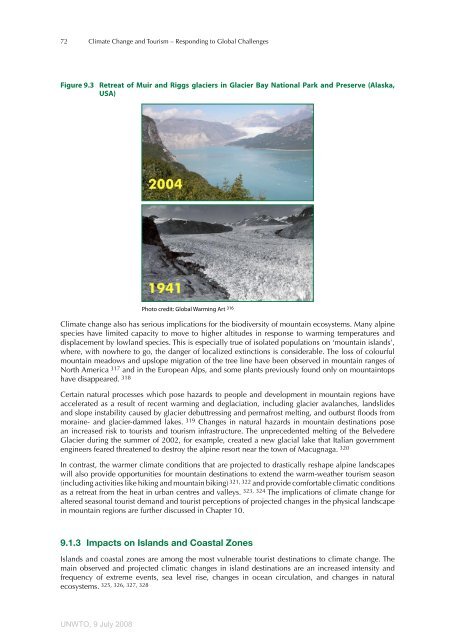Climate Change and Tourism - UNEP - Division of Technology ...
Climate Change and Tourism - UNEP - Division of Technology ...
Climate Change and Tourism - UNEP - Division of Technology ...
You also want an ePaper? Increase the reach of your titles
YUMPU automatically turns print PDFs into web optimized ePapers that Google loves.
72 <strong>Climate</strong> <strong>Change</strong> <strong>and</strong> <strong>Tourism</strong> – Responding to Global Challenges<br />
Figure 9.3 Retreat <strong>of</strong> Muir <strong>and</strong> Riggs glaciers in Glacier Bay National Park <strong>and</strong> Preserve (Alaska,<br />
USA)<br />
UNWTO, 9 July 2008<br />
Photo credit: Global Warming Art 316<br />
<strong>Climate</strong> change also has serious implications for the biodiversity <strong>of</strong> mountain ecosystems. Many alpine<br />
species have limited capacity to move to higher altitudes in response to warming temperatures <strong>and</strong><br />
displacement by lowl<strong>and</strong> species. This is especially true <strong>of</strong> isolated populations on ‘mountain isl<strong>and</strong>s’,<br />
where, with nowhere to go, the danger <strong>of</strong> localized extinctions is considerable. The loss <strong>of</strong> colourful<br />
mountain meadows <strong>and</strong> upslope migration <strong>of</strong> the tree line have been observed in mountain ranges <strong>of</strong><br />
North America 317 <strong>and</strong> in the European Alps, <strong>and</strong> some plants previously found only on mountaintops<br />
have disappeared. 318<br />
Certain natural processes which pose hazards to people <strong>and</strong> development in mountain regions have<br />
accelerated as a result <strong>of</strong> recent warming <strong>and</strong> deglaciation, including glacier avalanches, l<strong>and</strong>slides<br />
<strong>and</strong> slope instability caused by glacier debuttressing <strong>and</strong> permafrost melting, <strong>and</strong> outburst floods from<br />
moraine- <strong>and</strong> glacier-dammed lakes. 319 <strong>Change</strong>s in natural hazards in mountain destinations pose<br />
an increased risk to tourists <strong>and</strong> tourism infrastructure. The unprecedented melting <strong>of</strong> the Belvedere<br />
Glacier during the summer <strong>of</strong> 2002, for example, created a new glacial lake that Italian government<br />
engineers feared threatened to destroy the alpine resort near the town <strong>of</strong> Macugnaga. 320<br />
In contrast, the warmer climate conditions that are projected to drastically reshape alpine l<strong>and</strong>scapes<br />
will also provide opportunities for mountain destinations to extend the warm-weather tourism season<br />
(including activities like hiking <strong>and</strong> mountain biking) 321, 322 <strong>and</strong> provide comfortable climatic conditions<br />
as a retreat from the heat in urban centres <strong>and</strong> valleys. 323, 324 The implications <strong>of</strong> climate change for<br />
altered seasonal tourist dem<strong>and</strong> <strong>and</strong> tourist perceptions <strong>of</strong> projected changes in the physical l<strong>and</strong>scape<br />
in mountain regions are further discussed in Chapter 10.<br />
9.1.3 Impacts on Isl<strong>and</strong>s <strong>and</strong> Coastal Zones<br />
Isl<strong>and</strong>s <strong>and</strong> coastal zones are among the most vulnerable tourist destinations to climate change. The<br />
main observed <strong>and</strong> projected climatic changes in isl<strong>and</strong> destinations are an increased intensity <strong>and</strong><br />
frequency <strong>of</strong> extreme events, sea level rise, changes in ocean circulation, <strong>and</strong> changes in natural<br />
ecosystems. 325, 326, 327, 328

















